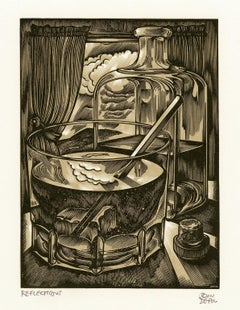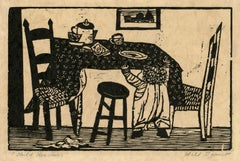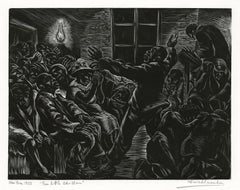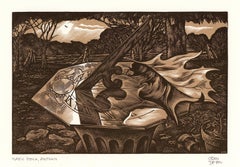Want more images or videos?
Request additional images or videos from the seller
1 of 3
Fred Becker'Public Building' — American Modernism, WPAc. 1937
c. 1937
$2,200List Price
About the Item
About the Seller
5.0
Recognized Seller
These prestigious sellers are industry leaders and represent the highest echelon for item quality and design.
Platinum Seller
Premium sellers with a 4.7+ rating and 24-hour response times
Established in 1995
1stDibs seller since 2016
328 sales on 1stDibs
Typical response time: 1 hour
Associations
International Fine Print Dealers Association
Authenticity Guarantee
In the unlikely event there’s an issue with an item’s authenticity, contact us within 1 year for a full refund. DetailsMoney-Back Guarantee
If your item is not as described, is damaged in transit, or does not arrive, contact us within 7 days for a full refund. Details24-Hour Cancellation
You have a 24-hour grace period in which to reconsider your purchase, with no questions asked.Vetted Professional Sellers
Our world-class sellers must adhere to strict standards for service and quality, maintaining the integrity of our listings.Price-Match Guarantee
If you find that a seller listed the same item for a lower price elsewhere, we’ll match it.Trusted Global Delivery
Our best-in-class carrier network provides specialized shipping options worldwide, including custom delivery.You May Also Like
Early Morning
By Will Barnet
Located in Buffalo, NY
A nice rare woodcut by the noted American Artist Will Barnet. This woodcut is from 1939 and is titled and pencil signed on the base "Early Morning", Will...
Category
1930s American Modern Figurative Prints
Materials
Paper, Woodcut
Wedding Party
Located in Buffalo, NY
An original mid century modern woodblock print.
This work is hand signed illegibly and titled "Wedding Party".
Category
1960s Modern Figurative Prints
Materials
Paper, Woodcut
Dolores
By Irene Zevon
Located in Buffalo, NY
An original woodblock print by female modern artist Irene Zevon edition 19/25 and dated 1979.
Zevon was inspired by the Flamenco dancer Dolores Vargas who used to practice in the ar...
Category
1970s Modern Figurative Prints
Materials
Woodcut
Dickie (Child in High Chair)
By Will Barnet
Located in Buffalo, NY
An original woodcut on japan paper created by master American artist Will Barnet in 1942.
Category
1940s American Modern Figurative Prints
Materials
Paper, Woodcut
Modern American Industrial Landscape
Located in Buffalo, NY
An original woodblock print dated 1965, titled "Our Town" but signed illegibly.
Category
1960s American Modern Figurative Prints
Materials
Paper, Woodcut
Page 47 from Si je mourais la-bas
By Georges Braque
Located in Palo Alto, CA
Created to accompany poetry in the book Si je mourais la-bas by Guillaume Apolliaire, this lovely woman detailed in a soft delicate profile we can only a...
Category
1960s Modern Figurative Prints
Materials
Engraving, Woodcut
Rancho Woodcut Heart, 1982
By Jim Dine
Located in Palo Alto, CA
One of Jim Dine’s most iconic motifs, the romantic Rancho Woodcut Heart work illustrates the story of hope and love through a symbolic image of a large red heart. With the contrast o...
Category
1980s Modern Figurative Prints
Materials
Woodcut
Swimmer
By Alex Katz
Located in Palo Alto, CA
Created in 1990, this color Woodcut on Echizen-Kozo paper is hand-signed by Alex Katz (Brooklyn, 1927 - ) in pencil in the lower right margin and is numbered from the edition of 100 ...
Category
1990s Modern Figurative Prints
Materials
Woodcut
Albany Monte Carlo
By Robert Bechtle
Located in Palo Alto, CA
Created in 1990, this color hard ground and soft ground etching is hand-signed by Robert Bechtle (San Francisco, 1932 - Berkeley, 2020) in pencil in the...
Category
1990s Modern Figurative Prints
Materials
Woodcut
Pinocchio
By Jim Dine
Located in Palo Alto, CA
Created in 2008, this woodcut is hand-signed by Jim Dine (Cincinnati, Ohio, 1935 –) on verso and is numbered from the edition of 118 on verso. Published by Lincoln Center List Poster & Print Program, New York.
About the Framing:
Framed to museum-grade, conservation standards, Jim Dine Pinocchio...
Category
Early 2000s Modern Figurative Prints
Materials
Screen, Woodcut
More From This Seller
View AllReflections
By John DePol
Located in Myrtle Beach, SC
John DePol, 'Reflections', chiaroscuro wood engraving, 1979, edition 160 in 1983. Signed, dated and titled in pencil. Signed in the block, lower right. A superb impression, on cream ...
Category
1970s American Modern Figurative Prints
Materials
Woodcut
'Child Reaching' — 1940s American Modernism
By Will Barnet
Located in Myrtle Beach, SC
Will barnet, 'Child Reaching', woodcut, 1940, edition 25, Cole 82. Signed and titled in pencil. A fine, black impression, on fibrous Japan paper, with full margins (5/8 to 1 3/4 inch...
Category
1940s American Modern Figurative Prints
Materials
Woodcut
'Run Little Chillun' also 'Revival' — African American Subject
Located in Myrtle Beach, SC
Isac Friedlander, 'Run Little Chillun' also 'Revival', wood engraving, 1933, edition 50. Signed, titled and annotated 'New York 1933' in pencil. A sup...
Category
1930s American Modern Figurative Prints
Materials
Woodcut
Magic Hour, Autumn
By John DePol
Located in Myrtle Beach, SC
John DePol, 'Magic Hour, Autumn', chiaroscuro wood engraving, 1981, edition 160 in 1983. Signed, dated and titled in pencil. Signed in the block, lower right. A superb impression, on...
Category
Mid-20th Century American Modern Figurative Prints
Materials
Woodcut
On the Beach (Coney Island, New York) — 1930s Graphic Modernism, WPA
By Lou Barlow
Located in Myrtle Beach, SC
Lou Barlow (Louis Breslow), 'On the Beach' (Coney Island) wood engraving, c. 1937, edition c. 25. Signed and titled in pencil. Stamped 'FEDERAL ART PROJECT NYC WPA' in the bottom left margin. A fine, richly-inked impression, with all the fine lines printing clearly, on cream wove paper, with full margins (1 1/2 to 3 inches), in excellent condition. Matted to museum standards, unframed. Scarce.
Image size 11 x 8 1/8 inches; sheet size 16 x 11 3/8 inches.
Created during the Great Depression for the Works Progress Administration (WPA), Federal Art Project, New York City.
Impressions of this work are in the permanent collections of the Amon Carter Museum of Art, Illinois State Museum, and the New York Public Library.
ABOUT THE IMAGE
Due to Coney Island's proximity to Manhattan, Brooklyn, and other New York boroughs, it began attracting vacationers in the 1830s and 1840s. Most of the vacationers were wealthy and went by carriage roads and steamship services that reduced travel time from a formerly half-day journey to two hours. By the late 1870s, the development of Coney Island's amusement park attractions and hotels drew people from all social classes. When the Brooklyn Rapid Transit Company electrified the steam railroads and connected Brooklyn to Manhattan via the Brooklyn Bridge at the beginning of the 20th century, Coney Island turned rapidly from a resort to an accessible location for day-trippers seeking to escape the summer heat in New York City's tenements. In 1915, the Sea Beach Line was upgraded to a subway line, and the opening of the Stillwell Avenue station in 1919 ushered in Coney Island's busiest era. On the peak summer days, over a million people would travel to Coney Island. In 1937, New York City purchased a 400-foot-wide strip of land along the shoreline to allow the boardwalk to be moved 300 feet inland. At this point, Coney Island was so crowded on summer weekends that parks commissioner Robert Moses...
Category
1930s American Modern Figurative Prints
Materials
Woodcut
Endless Day
By John DePol
Located in Myrtle Beach, SC
John DePol, 'Endless Day', chiaroscuro wood engraving, 1979, edition 160 in 1983. Signed, dated, and titled in pencil. Signed in the block, lower right. A superb impression, on off-w...
Category
1970s American Modern Figurative Prints
Materials
Woodcut



